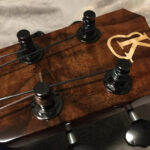Have you ever stopped to wonder why guitars are typically tuned to EADGBE? It might seem arbitrary, but the sequence of notes in standard guitar tuning is far from random. Its history is rich and deeply intertwined with the instrument’s evolution, offering a fascinating look into the practical and musical considerations that shaped the tuning we know today.
Unlike many other stringed instruments like violins, cellos, and mandolins, which have long favored tunings based on perfect fifths, the guitar took a different path. For over a millennium, musicians playing those instruments found that fifth intervals between strings provided optimal resonance and playability. In an all-fifths tuning, each open string would be a perfect fifth apart.
However, the guitar embraced a unique combination: a series of ascending perfect fourths punctuated by a single major third. Specifically, standard guitar tuning progresses from the low E string upwards through three perfect fourths (E to A, A to D, and D to G), followed by a major third (G to B), and finally another perfect fourth (B to the high E). This results in the familiar EADGBE sequence.
So, what led to this departure from the fifths-based tuning and the adoption of this seemingly unusual configuration? The answer lies in a blend of musical convenience and physical ergonomics that guitar players discovered centuries ago. The primary goal was to create a tuning that would simplify the transition between playing fundamental chords and common scales, ultimately minimizing the physical demands on the fretting hand.
This shift marked a significant change from earlier guitar-like instruments prevalent since the Renaissance. The four-course guitar, where a “course” referred to pairs of strings tuned in unison, was common during that era. The five-course guitarra battente, which emerged in 16th-century Italy, was tuned ADGBE. Interestingly, this tuning mirrors the top five strings of the modern six-string guitar, hinting at the historical roots of our current standard tuning.
The crucial innovation was tuning the third and second strings (G and B) to a major-third interval. Continuing the pattern of perfect fourths would have resulted in a second string tuned to C and the highest string to F. However, lowering that hypothetical high F by a half step to E created a perfect fourth interval between the first and second strings (B to E), mirroring the intervals lower down the fretboard. This seemingly small change had a profound impact on playability.
Renowned guitarist and music educator Richard Lloyd, formerly of the band Television, offered insightful perspective on this tuning choice. He pointed out that while the violin and cello’s shorter scale lengths are well-suited to fifths tuning, the larger scale length of the guitar presents different ergonomic challenges.
“The guitar is a larger-scaled instrument which is played sitting in one’s lap,” Lloyd explained. “Even though the cello is a larger instrument than the violin, it is played with the neck vertically, which allows the hand to have a little bit easier time reaching for notes. With the guitar sitting in the lap and the neck diagonal to the player, the bend in the wrist starts to make it more difficult to spread out the fingers. So our next best choice for tuning any larger scaled multi-stringed instrument is going to be to tune in fourths, which are a little closer together. On a guitar, a person with a normal-sized hand can reasonably be expected to sound the major third with the pinkie finger while holding down the tonic with the index finger. So it makes sense that the next string should be the fourth.”
Lloyd further highlighted a potential harmonic issue with tuning a six-string guitar entirely in perfect fourths. Such a tuning would result in EADGCF (from low to high). The problem here is the minor second interval between the E and F strings, a dissonant interval that Lloyd aptly described as “god-awful” and potentially “sour[ing] the whole thing.”
Fortunately, by the time the lower sixth string (tuned to E) was added to the guitar, the ADGBE tuning for the top five strings was already established since the 16th century. This pre-existing tuning avoided the problematic E-F interval. The addition of the low E string simply extended the pattern of perfect fourths, except for the major-third interval between the second and third strings. This historical development solidified the standard guitar tuning we still use today.
In conclusion, standard guitar tuning, EADGBE, isn’t just a convention; it’s a carefully crafted system born from centuries of refinement. It represents a practical compromise between musical intervals and ergonomic considerations, making the guitar accessible and versatile for countless players across genres and generations. This unique tuning system is a testament to the guitar’s rich history and its enduring appeal as a musical instrument.

